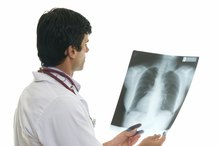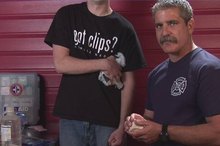Ribs Cracking and Stretching
If your ribs are cracking while stretching, pain is likely present as well. A rib fracture, costochondritis and sprain can all result in cracking if the rib cage is stretched. Consult your doctor for a proper diagnosis and treatment.
Identification
A fractured rib will sometimes make a crunching sound if you touch the point of injury. In addition, the rib-cage area could appear deformed, bruised and have muscle spasms. Stretching, taking deep breaths, coughing and sneezing are painful if your rib is fractured. Costochondritis, an inflammation in the area of the upper ribs, can also cause cracking and can be accompanied by tenderness and swelling. People with costochondritis sometimes mistake their symptoms for a heart attack. Costo-transverse sprains can also cause cracking and the pain will be most noticeable while stretching the ribs.
- A fractured rib will sometimes make a crunching sound if you touch the point of injury.
- Costo-transverse sprains can also cause cracking and the pain will be most noticeable while stretching the ribs.
Causes
When I Stretch My Rib Hurts
Learn More
A fractured rib is most often caused by direct trauma to the rib cage. Events like a persistent, severe cough or the Heimlich maneuver can fracture a rib. Costochondritis can be caused by trauma or physical strain from activities like weightlifting. A respiratory infection or fibromyalgia can also cause costochondritis. A costo-transverse sprain may be felt when you wake up in the morning after sleeping in an awkward position or have delayed pain from a minor trauma. A chronic cough can also cause a costo-transverse sprain.
- A fractured rib is most often caused by direct trauma to the rib cage.
- Costochondritis can be caused by trauma or physical strain from activities like weightlifting.
Treatment
Controlling the pain from a rib fracture is the primary means of treatment. A splint or cast cannot be worn for a fracture since it can restrict breathing and lead to pneumonia. Do not perform strenuous activities, and ice the area for up to 30 minutes every four hours. Narcotics may be used the first couple of weeks, followed by an over-the-counter nonsteroidal anti-inflammatory. If you’re experiencing long-term crunching and pain while stretching your ribs, your doctor can administer a corticosteroid injection. For acute costochondritis, nonsteroidal anti-inflammatories can also be used, as well as a muscle relaxant.
- Controlling the pain from a rib fracture is the primary means of treatment.
- A splint or cast cannot be worn for a fracture since it can restrict breathing and lead to pneumonia.
Prevention
Symptoms of Torn Cartilage in the Ribs
Learn More
If you participate in contact sports, always wear protective equipment since the ribs are vulnerable to fractures. A costo-transverse sprain is difficult to prevent because you may not know what caused the sprain. If you have a chronic cough, consult a doctor to determine if you have an underlying condition that requires treatment. Limit the amount of stretching that causes cracking in your ribs to decrease your risk of worsening the condition. Do not carry school bags that are so heavy that they cause one shoulder to slump.
- If you participate in contact sports, always wear protective equipment since the ribs are vulnerable to fractures.
- If you have a chronic cough, consult a doctor to determine if you have an underlying condition that requires treatment.
Related Articles
References
- Health Hype: Popping, Cracking, Clicking Sternum (Breastbone) Rib Joint
- ISIS Chiropractic Centres: Rib Pain and Chiropractic Treatment
- Ayloo A, Cvengros T, Marella S. Evaluation and treatment of musculoskeletal chest pain. Prim Care. 2013;40(4):863-87,viii. doi:10.1016/j.pop.2013.08.007
- Bellato E, Marini E, Castoldi F, et al. Fibromyalgia syndrome: etiology, pathogenesis, diagnosis, and treatment. Pain Res Treat. 2012;2012:426130. doi:10.1155/2012/426130
- Campbell KA, Madva EN, Villegas AC, et al. Non-cardiac chest pain: A review for the consultation-liaison psychiatrist. Psychosomatics. 2017;58(3):252-265. doi:10.1016/j.psym.2016.12.003
- Cubos J, Cubos A, Di Stefano F. Chronic costochondritis in an adolescent competitive swimmer: A case report. J Can Chiropr Assoc. 2010;54(4):271-275.
- Haviland MG, Banta JE, Przekop P. Fibromyalgia: Prevalence, course, and co-morbidities in hospitalized patients in the United States, 1999-2007. Clin Exp Rheumatol. 2011;29(6 Suppl 69):S79-87.
- Sturm C, Witte T. [Musculoskeletal-related chest pain]. Internist (Berl). 2017;58(1):39-46. doi:10.1007/s00108-016-0166-z
- Liptan GL. Fascia: A missing link in our understanding of the pathology of fibromyalgia. J Bodyw Mov Ther. 2010;14(1):3-12. doi:10.1016/j.jbmt.2009.08.003
- Zaruba RA, Wilson E. Impairment based examination and treatment of costochondritis: A case series. Int J Sports Phys Ther. 2017;12(3):458-467.
- Sawada K, Ihoriya H, Yamada T, et al. A patient presenting painful chest wall swelling: Tietze syndrome. World J Emerg Med. 2019;10(2):122-124. doi:10.5847/wjem.j.1920-8642.2019.02.011
- Hudes K. Low-tech rehabilitation and management of a 64 year old male patient with acute idiopathic onset of costochondritis. J Can Chiropr Assoc. 2008;52(4):224-228.
- Flowers, LK. Costochondritis. eMedicine.
- Haviland MG, Banta JE, Przekop P. Fibromyalgia: prevalence, course, and co-morbidities in hospitalized patients in the United States, 1999-2007. Clinical and Experimental Rheumatology. 2011;(6 Suppl 69):S79-87.
Writer Bio
Melissa McNamara is a certified personal trainer who holds a Bachelor of Arts in journalism and communication studies from the University of Iowa. She writes for various health and fitness publications while working toward a Bachelor of Science in nursing.








